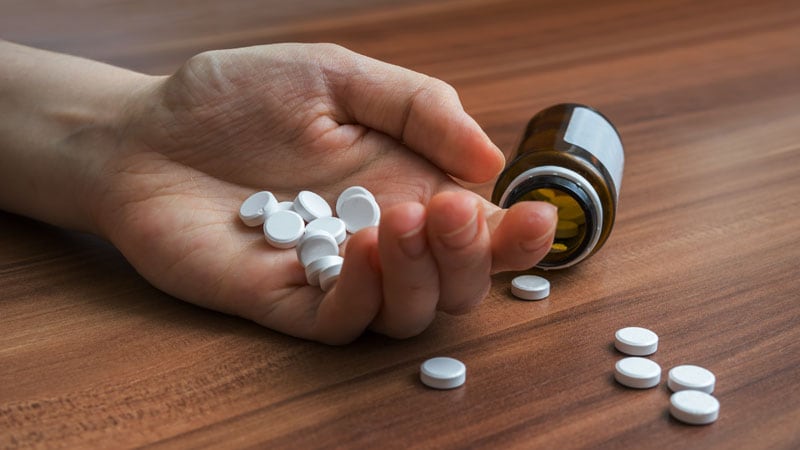A predictive rule that can help triage drug overdose patients for the risk for cardiac arrest, shock, ventricular dysrhythmias, or myocardial injury has been validated in a large research cohort.
“Cardiac events can complicate up to 16% of hospitalizations for acute drug overdose in the emergency department population,” Alex Manini, MD, Mount Sinai, New York City, told an online audience during his presentation at the American College of Emergency Physicians (ACEP) annual congress.
“We previously derived a risk prediction rule from acute drug overdose patients in [emergency department (ED)] patients which had a 97.1 negative predictive value,” Manini explained.
The previous risk prediction rule was derived from a single-center cohort of 459 patients with overdose presenting to the emergency department, and was published as Manini AF, et al. Acad Emerg Med Clinical risk factors for in-hospital adverse cardiovascular events after acute drug overdose. 2015 May;22(5):499-507. It was based on three risk factors: the presence of cardiac disease (coronary artery disease or coronary heart failure); the presence of metabolic acidosis, defined as an initial bicarbonate of less than 20 mEq/L) and prolonged QTc; or the presence of a QTc greater than 500 ms on the initial EKG taken from the ED.
The Mount Sinai researchers wanted to validate their prediction rule in a large external cohort. They looked at data spanning 3 years (from 2017 to 2019) from the Toxicology Investigators Consortium (ToxIC) Network and Registry, which contains emergency department overdose data contributed from over 65 US hospitals in 35 major cities.
They found 21,793 patients over the age of 18 in the database who received bedside medical toxicology consultation in the emergency department for suspected acute drug overdose over the 3-year period. They excluded 13,874 patients because they were pediatric, nondrug-related, chronically ill, international, or nonemergency, or had an alternative diagnosis. That left 7919 patients. The final cohort had a mean age of 39 years, 50.3% were female, and 27.7% reported suicidal ideation.
From this cohort, researchers found 845 who had suffered one or more adverse cardiovascular events (10.7%; confidence interval [CI], 10.0 – 11.4). Of those, 348 suffered a myocardial injury, 529 had shock, 81 dysrhythmia, and 183 experienced a cardiac arrest.
“There were a total of 131 deaths — a death rate of 1.7%,” Manini reported in his presentation.
Using a multivariable model for prediction of adverse cardiovascular events (ACVE) in this cohort, researchers found an odds ratio (OR) of 2.3 in patients with cardiac disease, OR 3.3 in patients with a bicarbonate of 22 mmol/L or less, and OR 2.6 in those with a QTc of equal to or greater than 500 ms. All three results were statistically significant (P = .0001).
Manini said that the presence of two or more risk factors was 96.4% specific. With a positive likelihood ratio of 4.33 (CI 3.5 – 5.4). “The presence of any factor showed a 5.8-fold increase of odds of an ACVE,” Manini noted, “which was statistically significant.”
When comparing the original study with more recent large external cohorts, the sensitivity, specificity, and negative predictive values were similar, Manini reported. Implementation studies are warranted to incorporate this into clinical practice, he said, and “future studies may also want to evaluate treatment modalities for those identified at high-risk.”
“This is important research,” Eric Lavonas, MD, Denver Health and the University of Colorado, wrote to Medscape in an email interview. “This rule allows hospitals to know with confidence which overdose patients are likely to develop life-threatening illness after admission to the hospital and might need to be admitted to intensive care, and which patients are at low risk and can safely be admitted to regular hospital wards.”
Jonathan Elmer, MD, University of Pittsburgh, Pennsylvania, agreed. In an email interview with Medscape, he said that rapid growth in overdose-related emergencies, hospitalizations, and deaths in America means that “accurately identifying patients at high risk of deterioration can allow providers to target resources appropriately.”
Elmer added that while this large multicenter study validates three straightforward predictors of major adverse cardiovascular events, including cardiac arrest, “the performance of this predictive model is insufficient to use in isolation.”
Still, he said, “the authors have given us a useful tool for risk stratification that can be used immediately to refine clinical care and patient triage after acute drug overdose.”
American College of Emergency Physicians (ACEP) 2020. Abstract #14. Presented October 24, 2020.
Elmer and Manini have disclosed no relevant financial relationships.
Ingrid Hein is a freelance health and technology reporter based in Hudson, Quebec.
For more news, follow Medscape on Facebook, Twitter, Instagram, and YouTube.
